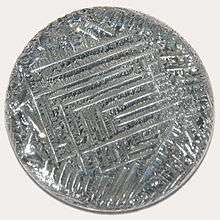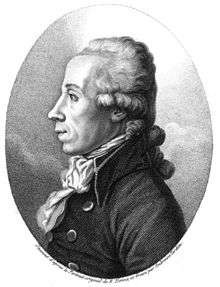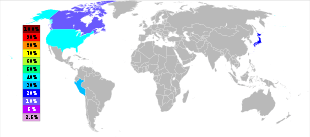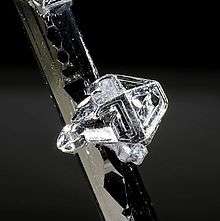Tellurium
Tellurium is a chemical element with the symbol Te and atomic number 52. It is a brittle, mildly toxic, rare, silver-white metalloid. Tellurium is chemically related to selenium and sulfur, all three of which are chalcogens. It is occasionally found in native form as elemental crystals. Tellurium is far more common in the Universe as a whole than on Earth. Its extreme rarity in the Earth's crust, comparable to that of platinum, is due partly to its formation of a volatile hydride that caused tellurium to be lost to space as a gas during the hot nebular formation of Earth,[6] and partly to tellurium's low affinity for oxygen, which causes it to bind preferentially to other chalcophiles in dense minerals that sink into the core.
 | |||||||||||||||||||||||||||||||||||||||||||||||||||||||||||||
| Tellurium | |||||||||||||||||||||||||||||||||||||||||||||||||||||||||||||
|---|---|---|---|---|---|---|---|---|---|---|---|---|---|---|---|---|---|---|---|---|---|---|---|---|---|---|---|---|---|---|---|---|---|---|---|---|---|---|---|---|---|---|---|---|---|---|---|---|---|---|---|---|---|---|---|---|---|---|---|---|---|
| Pronunciation | /tɪˈljʊəriəm/ | ||||||||||||||||||||||||||||||||||||||||||||||||||||||||||||
| Appearance | silvery lustrous gray (crystalline), brown-black powder (amorphous) | ||||||||||||||||||||||||||||||||||||||||||||||||||||||||||||
| Standard atomic weight Ar, std(Te) | 127.60(3)[1] | ||||||||||||||||||||||||||||||||||||||||||||||||||||||||||||
| Tellurium in the periodic table | |||||||||||||||||||||||||||||||||||||||||||||||||||||||||||||
| |||||||||||||||||||||||||||||||||||||||||||||||||||||||||||||
| Atomic number (Z) | 52 | ||||||||||||||||||||||||||||||||||||||||||||||||||||||||||||
| Group | group 16 (chalcogens) | ||||||||||||||||||||||||||||||||||||||||||||||||||||||||||||
| Period | period 5 | ||||||||||||||||||||||||||||||||||||||||||||||||||||||||||||
| Block | p-block | ||||||||||||||||||||||||||||||||||||||||||||||||||||||||||||
| Element category | Metalloid | ||||||||||||||||||||||||||||||||||||||||||||||||||||||||||||
| Electron configuration | [Kr] 4d10 5s2 5p4 | ||||||||||||||||||||||||||||||||||||||||||||||||||||||||||||
| Electrons per shell | 2, 8, 18, 18, 6 | ||||||||||||||||||||||||||||||||||||||||||||||||||||||||||||
| Physical properties | |||||||||||||||||||||||||||||||||||||||||||||||||||||||||||||
| Phase at STP | solid | ||||||||||||||||||||||||||||||||||||||||||||||||||||||||||||
| Melting point | 722.66 K (449.51 °C, 841.12 °F) | ||||||||||||||||||||||||||||||||||||||||||||||||||||||||||||
| Boiling point | 1261 K (988 °C, 1810 °F) | ||||||||||||||||||||||||||||||||||||||||||||||||||||||||||||
| Density (near r.t.) | 6.24 g/cm3 | ||||||||||||||||||||||||||||||||||||||||||||||||||||||||||||
| when liquid (at m.p.) | 5.70 g/cm3 | ||||||||||||||||||||||||||||||||||||||||||||||||||||||||||||
| Heat of fusion | 17.49 kJ/mol | ||||||||||||||||||||||||||||||||||||||||||||||||||||||||||||
| Heat of vaporization | 114.1 kJ/mol | ||||||||||||||||||||||||||||||||||||||||||||||||||||||||||||
| Molar heat capacity | 25.73 J/(mol·K) | ||||||||||||||||||||||||||||||||||||||||||||||||||||||||||||
Vapor pressure
| |||||||||||||||||||||||||||||||||||||||||||||||||||||||||||||
| Atomic properties | |||||||||||||||||||||||||||||||||||||||||||||||||||||||||||||
| Oxidation states | −2, −1, +1, +2, +3, +4, +5, +6 (a mildly acidic oxide) | ||||||||||||||||||||||||||||||||||||||||||||||||||||||||||||
| Electronegativity | Pauling scale: 2.1 | ||||||||||||||||||||||||||||||||||||||||||||||||||||||||||||
| Ionization energies |
| ||||||||||||||||||||||||||||||||||||||||||||||||||||||||||||
| Atomic radius | empirical: 140 pm | ||||||||||||||||||||||||||||||||||||||||||||||||||||||||||||
| Covalent radius | 138±4 pm | ||||||||||||||||||||||||||||||||||||||||||||||||||||||||||||
| Van der Waals radius | 206 pm | ||||||||||||||||||||||||||||||||||||||||||||||||||||||||||||
Color lines in a spectral range | |||||||||||||||||||||||||||||||||||||||||||||||||||||||||||||
| Other properties | |||||||||||||||||||||||||||||||||||||||||||||||||||||||||||||
| Natural occurrence | primordial | ||||||||||||||||||||||||||||||||||||||||||||||||||||||||||||
| Crystal structure | hexagonal | ||||||||||||||||||||||||||||||||||||||||||||||||||||||||||||
| Speed of sound thin rod | 2610 m/s (at 20 °C) | ||||||||||||||||||||||||||||||||||||||||||||||||||||||||||||
| Thermal expansion | 18 µm/(m·K)[2] (at r.t.) | ||||||||||||||||||||||||||||||||||||||||||||||||||||||||||||
| Thermal conductivity | 1.97–3.38 W/(m·K) | ||||||||||||||||||||||||||||||||||||||||||||||||||||||||||||
| Magnetic ordering | diamagnetic[3] | ||||||||||||||||||||||||||||||||||||||||||||||||||||||||||||
| Magnetic susceptibility | −39.5·10−6 cm3/mol (298 K)[4] | ||||||||||||||||||||||||||||||||||||||||||||||||||||||||||||
| Young's modulus | 43 GPa | ||||||||||||||||||||||||||||||||||||||||||||||||||||||||||||
| Shear modulus | 16 GPa | ||||||||||||||||||||||||||||||||||||||||||||||||||||||||||||
| Bulk modulus | 65 GPa | ||||||||||||||||||||||||||||||||||||||||||||||||||||||||||||
| Mohs hardness | 2.25 | ||||||||||||||||||||||||||||||||||||||||||||||||||||||||||||
| Brinell hardness | 180–270 MPa | ||||||||||||||||||||||||||||||||||||||||||||||||||||||||||||
| CAS Number | 13494-80-9 | ||||||||||||||||||||||||||||||||||||||||||||||||||||||||||||
| History | |||||||||||||||||||||||||||||||||||||||||||||||||||||||||||||
| Naming | after Roman Tellus, deity of the Earth | ||||||||||||||||||||||||||||||||||||||||||||||||||||||||||||
| Discovery | Franz-Joseph Müller von Reichenstein (1782) | ||||||||||||||||||||||||||||||||||||||||||||||||||||||||||||
| First isolation | Martin Heinrich Klaproth | ||||||||||||||||||||||||||||||||||||||||||||||||||||||||||||
| Main isotopes of tellurium | |||||||||||||||||||||||||||||||||||||||||||||||||||||||||||||
| |||||||||||||||||||||||||||||||||||||||||||||||||||||||||||||
Tellurium-bearing compounds were first discovered in 1782 in a gold mine in Kleinschlatten, Transylvania (now Zlatna, Romania) by Austrian mineralogist Franz-Joseph Müller von Reichenstein, although it was Martin Heinrich Klaproth who named the new element in 1798 after the Latin word for "earth", tellus. Gold telluride minerals are the most notable natural gold compounds. However, they are not a commercially significant source of tellurium itself, which is normally extracted as a by-product of copper and lead production.
Commercially, the primary use of tellurium is copper (tellurium copper) and steel alloys, where it improves machinability. Applications in CdTe solar panels and cadmium telluride semiconductors also consume a considerable portion of tellurium production. Tellurium is considered a technology-critical element.
Tellurium has no biological function, although fungi can use it in place of sulfur and selenium in amino acids such as tellurocysteine and telluromethionine.[7] In humans, tellurium is partly metabolized into dimethyl telluride, (CH3)2Te, a gas with a garlic-like odor exhaled in the breath of victims of tellurium exposure or poisoning.
Characteristics
Physical properties
Tellurium has two allotropes, crystalline and amorphous. When crystalline, tellurium is silvery-white with a metallic luster. It is a brittle and easily pulverized metalloid. Amorphous tellurium is a black-brown powder prepared by precipitating it from a solution of tellurous acid or telluric acid (Te(OH)6).[8] Tellurium is a semiconductor that shows a greater electrical conductivity in certain directions depending on atomic alignment; the conductivity increases slightly when exposed to light (photoconductivity).[9] When molten, tellurium is corrosive to copper, iron, and stainless steel. Of the chalcogens (oxygen-family elements), tellurium has the highest melting and boiling points, at 722.66 K (841.12 °F) and 1,261 K (1,810 °F), respectively.[10]
Chemical properties
Tellurium adopts a polymeric structure consisting of zig-zag chains of Te atoms. This gray material resists oxidation by air and is not volatile.
Isotopes
Naturally occurring tellurium has eight isotopes. Six of those isotopes, 120Te, 122Te, 123Te, 124Te, 125Te, and 126Te, are stable. The other two, 128Te and 130Te, have been found to be slightly radioactive,[11][12][13] with extremely long half-lives, including 2.2 × 1024 years for 128Te. This is the longest known half-life among all radionuclides[14] and is about 160 trillion (1012) times the age of the known universe. Stable isotopes comprise only 33.2% of naturally occurring tellurium.
A further 31 artificial radioisotopes of tellurium are known, with atomic masses ranging from 104 to 142 and with half-lives of 19 days or less. Also, 17 nuclear isomers are known, with half-lives up to 154 days. With the exception of beryllium-8 and beta-delayed alpha emission branches in some lighter nuclides, tellurium (104Te to 109Te) is the lightest element with isotopes known to undergo alpha decay.[11]
The atomic mass of tellurium (127.60 g·mol−1) exceeds that of iodine (126.90 g·mol−1), the next element in the periodic table.[15]
Occurrence

With an abundance in the Earth's crust comparable to that of platinum (about 1 µg/kg), tellurium is one of the rarest stable solid elements.[16] In comparison, even the rarest of the stable lanthanides have crustal abundances of 500 µg/kg (see Abundance of the chemical elements).[17]
This rarity of tellurium in the Earth's crust is not a reflection of its cosmic abundance. Tellurium is more abundant than rubidium in the cosmos, though rubidium is 10,000 times more abundant in the Earth's crust. The rarity of tellurium on Earth is thought to be caused by conditions during preaccretional sorting in the solar nebula, when the stable form of certain elements, in the absence of oxygen and water, was controlled by the reductive power of free hydrogen. Under this scenario, certain elements that form volatile hydrides, such as tellurium, were severely depleted through evaporation of these hydrides. Tellurium and selenium are the heavy elements most depleted by this process.[6]
Tellurium is sometimes found in its native (i.e., elemental) form, but is more often found as the tellurides of gold such as calaverite and krennerite (two different polymorphs of AuTe2), petzite, Ag3AuTe2, and sylvanite, AgAuTe4. The city of Telluride, Colorado, was named in hope of a strike of gold telluride (which never materialized, though gold metal ore was found). Gold itself is usually found uncombined, but when found as a chemical compound, it is most often combined with tellurium.
Although tellurium is found with gold more often than in uncombined form, it is found even more often combined as tellurides of more common metals (e.g. melonite, NiTe2). Natural tellurite and tellurate minerals also occur, formed by oxidation of tellurides near the Earth's surface. In contrast to selenium, tellurium does not usually replace sulfur in minerals because of the great difference in ion radii. Thus, many common sulfide minerals contain substantial quantities of selenium and only traces of tellurium.[18]
In the gold rush of 1893, miners in Kalgoorlie discarded a pyritic material as they searched for pure gold, and it was used to fill in potholes and build sidewalks. In 1896, that tailing was discovered to be calaverite, a telluride of gold, and it sparked a second gold rush that included mining the streets.[19]
History

Tellurium (Latin tellus meaning "earth") was discovered in the 18th century in a gold ore from the mines in Kleinschlatten (today Zlatna), near today's city of Alba Iulia, Romania. This ore was known as "Faczebajer weißes blättriges Golderz" (white leafy gold ore from Faczebaja, German name of Facebánya, now Fața Băii in Alba County) or antimonalischer Goldkies (antimonic gold pyrite), and according to Anton von Rupprecht, was Spießglaskönig (argent molybdique), containing native antimony.[20][21] In 1782 Franz-Joseph Müller von Reichenstein, who was then serving as the Austrian chief inspector of mines in Transylvania, concluded that the ore did not contain antimony but was bismuth sulfide.[22] The following year, he reported that this was erroneous and that the ore contained mostly gold and an unknown metal very similar to antimony. After a thorough investigation that lasted three years and included more than fifty tests, Müller determined the specific gravity of the mineral and noted that when heated, the new metal gives off a white smoke with a radish-like odor; that it imparts a red color to sulfuric acid; and that when this solution is diluted with water, it has a black precipitate. Nevertheless, he was not able to identify this metal and gave it the names aurum paradoxum (paradoxical gold) and metallum problematicum (problem metal), because it did not exhibit the properties predicted for antimony.[23][24][25]
In 1789, a Hungarian scientist, Pál Kitaibel, discovered the element independently in an ore from Deutsch-Pilsen that had been regarded as argentiferous molybdenite, but later he gave the credit to Müller. In 1798, it was named by Martin Heinrich Klaproth, who had earlier isolated it from the mineral calaverite.[26][24][25][27]
The 1960s brought an increase in thermoelectric applications for tellurium (as bismuth telluride), and in free-machining steel alloys, which became the dominant use.[28]
Production
The principal source of tellurium is from anode sludges from the electrolytic refining of blister copper. It is a component of dusts from blast furnace refining of lead. Treatment of 1000 tons of copper ore typically yields one kilogram (2.2 pounds) of tellurium.

The anode sludges contain the selenides and tellurides of the noble metals in compounds with the formula M2Se or M2Te (M = Cu, Ag, Au). At temperatures of 500 °C the anode sludges are roasted with sodium carbonate under air. The metal ions are reduced to the metals, while the telluride is converted to sodium tellurite.[29]
- M2Te + O2 + Na2CO3 → Na2TeO3 + 2 M + CO2
Tellurites can be leached from the mixture with water and are normally present as hydrotellurites HTeO3− in solution. Selenites are also formed during this process, but they can be separated by adding sulfuric acid. The hydrotellurites are converted into the insoluble tellurium dioxide while the selenites stay in solution.[29]
- HTeO−
3 + OH− + H2SO4 → TeO2 + SO2−
4 + 2 H2O
The metal is produced from the oxide (reduced) either by electrolysis or by reacting the tellurium dioxide with sulfur dioxide in sulfuric acid.[29]
- TeO2 + 2 SO2 + 2H2O → Te + 2 SO2−
4 + 4 H+
Commercial-grade tellurium is usually marketed as 200-mesh powder but is also available as slabs, ingots, sticks, or lumps. The year-end price for tellurium in 2000 was US$14 per pound. In recent years, the tellurium price was driven up by increased demand and limited supply, reaching as high as US$100 per pound in 2006.[30][31] Despite the expectation that improved production methods will double production, the United States Department of Energy (DoE) anticipates a supply shortfall of tellurium by 2025.[32]
Tellurium is produced mainly in the United States, Peru, Japan and Canada.[33] The British Geological Survey gives the following production numbers for 2009: United States 50 t, Peru 7 t, Japan 40 t and Canada 16 t.[34]
Compounds
Tellurium belongs to the chalcogen (group 16) family of elements on the periodic table, which also includes oxygen, sulfur, selenium and polonium: Tellurium and selenium compounds are similar. Tellurium exhibits the oxidation states −2, +2, +4 and +6, with +4 being most common.[8]
- Tellurides
Reduction of Te metal produces the tellurides and polytellurides, Ten2−. The −2 oxidation state is exhibited in binary compounds with many metals, such as zinc telluride, ZnTe, produced by heating tellurium with zinc.[35] Decomposition of ZnTe with hydrochloric acid yields hydrogen telluride (H
2Te), a highly unstable analogue of the other chalcogen hydrides, H
2O, H
2S and H
2Se:
- ZnTe + 2 HCl → ZnCl
2 + H
2Te
H
2Te is unstable, whereas salts of its conjugate base [TeH]− are stable.
- Halides
The +2 oxidation state is exhibited by the dihalides, TeCl
2, TeBr
2 and TeI
2. The dihalides have not been obtained in pure form,[36]:274 although they are known decomposition products of the tetrahalides in organic solvents, and the derived tetrahalotellurates are well-characterized:
- Te + X
2 + 2 X−
→ TeX2−
4
where X is Cl, Br, or I. These anions are square planar in geometry.[36]:281 Polynuclear anionic species also exist, such as the dark brown Te
2I2−
6,[36]:283 and the black Te
4I2−
14.[36]:285
Fluorine forms two halides with tellurium: the mixed-valence Te
2F
4 and TeF
6. In the +6 oxidation state, the –OTeF
5 structural group occurs in a number of compounds such as HOTeF
5, B(OTeF
5)
3, Xe(OTeF
5)
2, Te(OTeF
5)
4 and Te(OTeF
5)
6.[37] The square antiprismatic anion TeF2−
8 is also attested.[29] The other halogens do not form halides with tellurium in the +6 oxidation state, but only tetrahalides (TeCl
4, TeBr
4 and TeI
4) in the +4 state, and other lower halides (Te
3Cl
2, Te
2Cl
2, Te
2Br
2, Te
2I and two forms of TeI). In the +4 oxidation state, halotellurate anions are known, such as TeCl2−
6 and Te
2Cl2−
10. Halotellurium cations are also attested, including TeI+
3, found in TeI
3AsF
6.[38]
- Oxocompounds

Tellurium monoxide was first reported in 1883 as a black amorphous solid formed by the heat decomposition of TeSO
3 in vacuum, disproportionating into tellurium dioxide, TeO
2 and elemental tellurium upon heating.[39][40] Since then, however, existence in the solid phase is doubted and in dispute, although it is known as a vapor fragment; the black solid may be merely an equimolar mixture of elemental tellurium and tellurium dioxide.[41]
Tellurium dioxide is formed by heating tellurium in air, where it burns with a blue flame.[35] Tellurium trioxide, β-TeO
3, is obtained by thermal decomposition of Te(OH)
6. The other two forms of trioxide reported in the literature, the α- and γ- forms, were found not to be true oxides of tellurium in the +6 oxidation state, but a mixture of Te4+
, OH−
and O−
2.[42] Tellurium also exhibits mixed-valence oxides, Te
2O
5 and Te
4O
9.[42]
The tellurium oxides and hydrated oxides form a series of acids, including tellurous acid (H
2TeO
3), orthotelluric acid (Te(OH)
6) and metatelluric acid ((H
2TeO
4)
n).[41] The two forms of telluric acid form tellurate salts containing the TeO2–
4 and TeO6−
6 anions, respectively. Tellurous acid forms tellurite salts containing the anion TeO2−
3.
- Zintl cations
When tellurium is treated with concentrated sulfuric acid, the result is a red solution of the Zintl ion, Te2+
4.[43] The oxidation of tellurium by AsF
5 in liquid SO
2 produces the same square planar cation, in addition to the trigonal prismatic, yellow-orange Te4+
6:[29]
- 4 Te + 3 AsF
5 → Te2+
4(AsF−
6)
2 + AsF
3 - 6 Te + 6 AsF
5 → Te4+
6(AsF−
6)
4 + 2 AsF
3
Other tellurium Zintl cations include the polymeric Te2+
7 and the blue-black Te2+
8, consisting of two fused 5-membered tellurium rings. The latter cation is formed by the reaction of tellurium with tungsten hexachloride:[29]
- 8 Te + 2 WCl
6 → Te2+
8(WCl−
6)
2
Interchalcogen cations also exist, such as Te
2Se2+
6 (distorted cubic geometry) and Te
2Se2+
8. These are formed by oxidizing mixtures of tellurium and selenium with AsF
5 or SbF
5.[29]
- Organotellurium compounds
Tellurium does not readily form analogues of alcohols and thiols, with the functional group –TeH, that are called tellurols. The –TeH functional group is also attributed using the prefix tellanyl-.[44] Like H2Te, these species are unstable with respect to loss of hydrogen. Telluraethers (R–Te–R) are more stable, as are telluroxides.
Applications
Metallurgy
The largest consumer of tellurium is metallurgy in iron, stainless steel, copper, and lead alloys. The addition to steel and copper produces an alloy more machinable than otherwise. It is alloyed into cast iron for promoting chill for spectroscopy, where the presence of electrically conductive free graphite tends to interfere with spark emission testing results. In lead, tellurium improves strength and durability, and decreases the corrosive action of sulfuric acid.[28][45]
Semiconductor and electronic industry uses

Tellurium is used in cadmium telluride (CdTe) solar panels. National Renewable Energy Laboratory lab tests of tellurium demonstrated some of the greatest efficiencies for solar cell electric power generators. Massive commercial production of CdTe solar panels by First Solar in recent years has significantly increased tellurium demand.[46][47][48] Replacing some of the cadmium in CdTe by zinc, producing (Cd,Zn)Te, produces a solid-state X-ray detector, providing an alternative to single-use film badges.[49]
Infrared sensitive semiconductor material is formed by alloying tellurium with cadmium and mercury to form mercury cadmium telluride.[50]
Organotellurium compounds such as dimethyl telluride, diethyl telluride, diisopropyl telluride, diallyl telluride and methyl allyl telluride are precursors for synthesizing metalorganic vapor phase epitaxy growth of II-VI compound semiconductors.[51] Diisopropyl telluride (DIPTe) is the preferred precursor for low-temperature growth of CdHgTe by MOVPE.[52] The greatest purity metalorganics of both selenium and tellurium are used in these processes. The compounds for semiconductor industry and are prepared by adduct purification.[53][54]
Tellurium, as tellurium suboxide, is used in the media layer of rewritable optical discs, including ReWritable Compact Discs (CD-RW), ReWritable Digital Video Discs (DVD-RW), and ReWritable Blu-ray Discs.[55][56]
Tellurium dioxide is used to create acousto-optic modulators (AOTFs and AOBSs) for confocal microscopy.
Tellurium is used in the new phase change memory chips[57] developed by Intel.[58] Bismuth telluride (Bi2Te3) and lead telluride are working elements of thermoelectric devices. Lead telluride is used in far-infrared detectors.
Other uses
- Tellurium compounds are used as pigments for ceramics.[59]
- Selenides and tellurides greatly increase the optical refraction of glass widely used in glass optical fibers for telecommunications.[60][61]
- Mixtures of selenium and tellurium are used with barium peroxide as an oxidizer in the delay powder of electric blasting caps.[62]
- Organic tellurides have been employed as initiators for living radical polymerization and electron-rich mono- and di-tellurides possess antioxidant activity. The tellurium compounds are used widely in synthetic organic chemistry for reduction- and oxidation-, cyclofunctionalization-, dehalogenation-, carbanion generation reactions and removal of protecting groups.[63] The organometallic compounds are intermediates in the synthesis of amines, diols, and natural products.[64]
- Rubber can be vulcanized with tellurium instead of sulfur or selenium. The rubber produced in this way shows improved heat resistance.[65]
- Tellurite agar is used to identify members of the corynebacterium genus, most typically Corynebacterium diphtheriae, the pathogen responsible for diphtheria.[66]
- Tellurium is a key constituent of high performing mixed oxide catalysts for the heterogeneous catalytic selective oxidation of propane to acrylic acid.[67][68] The surface elemental composition changes dynamically and reversibly with the reaction conditions. In the presence of steam the surface of the catalyst is enriched in tellurium and vanadium which translates into the enhancement of the acrylic acid production.[69][70]
- Neutron bombardment of tellurium is the most common way to produce iodine-131.[71] This in turn is used to treat some thyroid conditions, and as a tracer compound in hydraulic fracturing, among other applications.
Biological role
Tellurium has no known biological function, although fungi can incorporate it in place of sulfur and selenium into amino acids such as telluro-cysteine and telluro-methionine.[7][72] Organisms have shown a highly variable tolerance to tellurium compounds. Many bacteria, such as Pseudomonas aeruginosa, take up tellurite and reduce it to elemental tellurium, which accumulates and causes a characteristic and often dramatic darkening of cells.[73] In yeast, this reduction is mediated by the sulfate assimilation pathway.[74] Tellurium accumulation seems to account for a major part of the toxicity effects. Many organisms also metabolize tellurium partly to form dimethyl telluride, although dimethyl ditelluride is also formed by some species. Dimethyl telluride has been observed in hot springs at very low concentrations.[75][76]
Precautions
| Hazards | |
|---|---|
| GHS pictograms |   |
| GHS Signal word | Danger |
GHS hazard statements |
H317, H332, H360, H412 |
| P201, P261, P280, P308+313[77] | |
| NFPA 704 (fire diamond) | |
Tellurium and tellurium compounds are considered to be mildly toxic and need to be handled with care, although acute poisoning is rare.[78] Tellurium poisoning is particularly difficult to treat as many chelation agents used in the treatment of metal poisoning will increase the toxicity of tellurium. Tellurium is not reported to be carcinogenic.[78]
Humans exposed to as little as 0.01 mg/m3 or less in air exude a foul garlic-like odor known as "tellurium breath".[59][79] This is caused by the body converting tellurium from any oxidation state to dimethyl telluride, (CH3)2Te. This is a volatile compound with a pungent garlic-like smell. Even though the metabolic pathways of tellurium are not known, it is generally assumed that they resemble those of the more extensively studied selenium because the final methylated metabolic products of the two elements are similar.[80][81][82]
People can be exposed to tellurium in the workplace by inhalation, ingestion, skin contact, and eye contact. The Occupational Safety and Health Administration (OSHA) limits (permissible exposure limit) tellurium exposure in the workplace to 0.1 mg/m3 over an eight-hour workday. The National Institute for Occupational Safety and Health (NIOSH) has set the recommended exposure limit (REL) at 0.1 mg/m3 over an eight-hour workday. In concentrations of 25 mg/m3, tellurium is immediately dangerous to life and health.[83]
See also
- The 1862 telluric helix of Alexandre-Émile Béguyer de Chancourtois.
References
- Meija, Juris; et al. (2016). "Atomic weights of the elements 2013 (IUPAC Technical Report)". Pure and Applied Chemistry. 88 (3): 265–91. doi:10.1515/pac-2015-0305.
- Cverna, Fran (2002). "Ch. 2 Thermal Expansion". ASM Ready Reference: Thermal properties of metals (PDF). ASM International. ISBN 978-0-87170-768-0.
- Lide, D. R., ed. (2005). "Magnetic susceptibility of the elements and inorganic compounds". CRC Handbook of Chemistry and Physics (PDF) (86th ed.). Boca Raton (FL): CRC Press. ISBN 0-8493-0486-5.
- Weast, Robert (1984). CRC, Handbook of Chemistry and Physics. Boca Raton, Florida: Chemical Rubber Company Publishing. pp. E110. ISBN 0-8493-0464-4.
- Alessandrello, A.; Arnaboldi, C.; Brofferio, C.; Capelli, S.; Cremonesi, O.; Fiorini, E.; Nucciotti, A.; Pavan, M.; Pessina, G.; Pirro, S.; Previtali, E.; Sisti, M.; Vanzini, M.; Zanotti, L.; Giuliani, A.; Pedretti, M.; Bucci, C.; Pobes, C. (2003). "New limits on naturally occurring electron capture of 123Te". Physical Review C. 67: 014323. arXiv:hep-ex/0211015. Bibcode:2003PhRvC..67a4323A. doi:10.1103/PhysRevC.67.014323.
- Anderson, Don L.; "Chemical Composition of the Mantle" in Theory of the Earth, pp. 147-175 ISBN 0865421234
- Ramadan, Shadia E.; Razak, A. A.; Ragab, A. M.; El-Meleigy, M. (1989). "Incorporation of tellurium into amino acids and proteins in a tellurium-tolerant fungi". Biological Trace Element Research. 20 (3): 225–32. doi:10.1007/BF02917437. PMID 2484755.
- Leddicotte, G. W. (1961). "The radiochemistry of tellurium" (PDF). Nuclear science series (3038). Subcommittee on Radiochemistry, National Academy of Sciences-National Research Council: 5. Cite journal requires
|journal=(help) - Berger, Lev Isaakovich (1997). "Tellurium". Semiconductor materials. CRC Press. pp. 89–91. ISBN 978-0-8493-8912-2.
- Periodic Table. ptable.com
- Audi, G.; Bersillon, O.; Blachot, J.; Wapstra, A. H. (2003). "The NUBASE Evaluation of Nuclear and Decay Properties". Nuclear Physics A. Atomic Mass Data Center. 729 (1): 3–128. Bibcode:2003NuPhA.729....3A. doi:10.1016/j.nuclphysa.2003.11.001.
- "WWW Table of Radioactive Isotopes: Tellurium". Nuclear Science Division, Lawrence Berkeley National Laboratory. 2008. Archived from the original on 2010-02-05. Retrieved 2010-01-16.
- Alessandrello, A.; Arnaboldi, C.; Brofferio, C.; Capelli, S.; Cremonesi, O.; Fiorini, E.; Nucciotti, A.; Pavan, M.; Pessina, G.; Pirro, S.; Previtali, E.; Sisti, M.; Vanzini, M.; Zanotti, L.; Giuliani, A.; Pedretti, M.; Bucci, C.; Pobes, C. (2003). "New limits on naturally occurring electron capture of 123Te". Physical Review C. 67 (1): 014323. arXiv:hep-ex/0211015. Bibcode:2003PhRvC..67a4323A. doi:10.1103/PhysRevC.67.014323.
- "Noble Gas Research". Laboratory for Space Sciences, Washington University in St. Louis. 2008. Archived from the original on September 28, 2011. Retrieved 2013-01-10.
- Emsley, John (2003). "Tellurium". Nature's building blocks: an A-Z guide to the elements. Oxford University Press. pp. 426–429. ISBN 978-0-19-850340-8.
- Ayres, Robert U.; Ayres, Leslie (2002). A handbook of industrial ecology. Edward Elgar Publishing. p. 396. ISBN 1-84064-506-7.
- Suess, Hans; Urey, Harold (1956). "Abundances of the Elements". Reviews of Modern Physics. 28 (1): 53–74. Bibcode:1956RvMP...28...53S. doi:10.1103/RevModPhys.28.53.
- Nekrasov, I. Y. (1996). "Phase Relations in the Selenide Telluride Systems". Geochemistry, mineralogy and genesis of gold deposits. Taylor & Francis. pp. 217–256. ISBN 978-90-5410-723-1.
- Fortey, Richard (2004). The Earth: An Intimate History. Harper Perennial. p. 230. ISBN 978-0-00-257011-4.
- v. Born, Abh. Privatges. v. Böhmen 5 (1782): 383.
- Rupprecht, von, A. (1783). "Über den vermeintlichen siebenbürgischen natürlichen Spiessglaskönig" [On the supposedly native antimony of Transylvania]. Physikalische Arbeiten der Einträchtigen Freunde in Wien. 1 (1): 70–74.
- Müller, F. J. (1783). "Über den vermeintlichen natürlichen Spiessglaskönig". Physikalische Arbeiten der Einträchtigen Freunde in Wien. 1 (1): 57–59.
- von Reichenstein, F. J. M. (1783). "Versuche mit dem in der Grube Mariahilf in dem Gebirge Fazebay bey Zalathna vorkommenden vermeinten gediegenen Spiesglaskönig" [Experiments with supposedly native antimony occurring in the Mariahilf mine in the Fazeby mountains near Zalathna]. Physikalische Arbeiten der Einträchtigen Freunde in Wien. 1783 (1.Quartal): 63–69.
- Diemann, Ekkehard; Müller, Achim; Barbu, Horia (2002). "Die spannende Entdeckungsgeschichte des Tellurs (1782–1798) Bedeutung und Komplexität von Elemententdeckungen". Chemie in Unserer Zeit. 36 (5): 334–337. doi:10.1002/1521-3781(200210)36:5<334::AID-CIUZ334>3.0.CO;2-1.
- Weeks, Mary Elvira (1932). "The discovery of the elements. VI. Tellurium and selenium". Journal of Chemical Education. 9 (3): 474–485. Bibcode:1932JChEd...9..474W. doi:10.1021/ed009p474.
- Klaproth (1798) "Ueber die siebenbürgischen Golderze, und das in selbigen enthaltene neue Metall" (On the Transylvanian gold ore, and the new metal contained in it), Chemische Annalen für die Freunde der Naturlehre, Arzneygelahrtheit, Haushaltungskunst und Manufacturen (Chemical Annals for the Friends of Science, Medicine, Economics, and Manufacturing), 1 : 91–104. From page 100: " … ; und welchem ich hiermit den, von der alten Muttererde entlehnten, Namen Tellurium beylege." ( … ; and to which I hereby bestow the name tellurium, derived from the old Mother of the Earth.)
- Weeks, Mary Elvira (1935). "The discovery of tellurium". Journal of Chemical Education. 12 (9): 403–408. Bibcode:1935JChEd..12..403W. doi:10.1021/ed012p403.
- George, Micheal W. (2007). "Mineral Yearbook 2007: Selenium and Tellurium" (PDF). United States geological Survey.
- Wiberg, Egon; Holleman, Arnold Frederick (2001). Nils Wiberg (ed.). Inorganic chemistry. translated by Mary Eagleson. Academic Press. p. 588. ISBN 0-12-352651-5.
- "An Arizona tellurium rush?". arizonageology.blogspot.com. May 21, 2007. Retrieved 2009-08-08.
- "Byproducts Part I: Is There a Tellurium Rush in the Making?". resourceinvestor.com. April 19, 2007. Retrieved 2009-08-08.
- Crow, James Mitchell (2011). "13 elements you can't live without". New Scientist. 210 (2817): 39. Bibcode:2011NewSc.210...36C. doi:10.1016/S0262-4079(11)61452-8.
- Addicks, Lawrence (2008). "By-Products". Copper Refining. Read books. pp. 111–114. ISBN 978-1-4437-3230-7.
- Brown, T. J. (2011). World mineral statistics British Geological Survey. Keyworth, Nottingham. p. 95. ISBN 978-0-85272-677-8.
- Roscoe, Henry Enfield; Schorlemmer, Carl (1878). A treatise on chemistry. 1. Appleton. pp. 367–368.
- Emeleus, H. J. (1990). A. G. Sykes (ed.). Advances in Inorganic Chemistry. 35. Academic Press. ISBN 0-12-023635-4.
- Holloway, John H.; Laycock, David (1983). "Preparations and Reactions of Inorganic Main-Group Oxide-Fluorides". In Harry Julius Emeléus; A. G. Sharpe (eds.). Advances in inorganic chemistry and radiochemistry. Serial Publication Series. 27. Academic Press. p. 174. ISBN 0-12-023627-3.
- Xu, Zhengtao (2007). "Recent developments in binary halogen-chalcogen compounds, polyanions and polycations". In Francesco A. Devillanova (ed.). Handbook of chalcogen chemistry: new perspectives in sulfur, selenium and tellurium. Royal Society of Chemistry. pp. 457–466. ISBN 978-0-85404-366-8.
- Schwartz, Mel M. (2002). "Tellurium". Encyclopedia of materials, parts, and finishes (2nd ed.). CRC Press. ISBN 1-56676-661-3.
- Divers, Edward; Shimosé, M. (1883). "On a new oxide of tellurium". Journal of the Chemical Society. 43: 319–323. doi:10.1039/CT8834300319.
- Dutton, W. A.; Cooper, W. Charles (1966). "The Oxides and Oxyacids of Tellurium". Chemical Reviews. 66 (6): 657–675. doi:10.1021/cr60244a003.
- Wickleder, Mathias S. (2007). "Chalcogen-Oxygen Chemistry". In Francesco A. Devillanova (ed.). Handbook of chalcogen chemistry: new perspectives in sulfur, selenium and tellurium. Royal Society of Chemistry. pp. 348–350. ISBN 978-0-85404-366-8.
- Molnar, Arpad; Olah, George Andrew; Surya Prakash, G. K.; Sommer, Jean (2009). Superacid Chemistry (2nd ed.). Wiley-Interscience. pp. 444–445. ISBN 978-0-471-59668-4.
- Sadekov, I. D.; Zakharov, A. V. (1999). "Stable tellurols and their metal derivatives". Russian Chemical Reviews. 68 (11): 909–923. Bibcode:1999RuCRv..68..909S. doi:10.1070/RC1999v068n11ABEH000544.
- Guo, W. X.; Shu, D.; Chen, H. Y.; Li, A. J.; Wang, H.; Xiao, G. M.; Dou, C. L.; Peng, S. G.; Wei, W. W.; Zhang, W.; Zhou, H. W.; Chen, S. (2009). "Study on the structure and property of lead tellurium alloy as the positive grid of lead-acid batteries". Journal of Alloys and Compounds. 475 (1–2): 102–109. doi:10.1016/j.jallcom.2008.08.011.
- Fthenakis, Vasilis M.; Kim, Hyung Chul; Alsema, Erik (2008). "Emissions from Photovoltaic Life Cycles". Environmental Science & Technology. 42 (6): 2168–2174. Bibcode:2008EnST...42.2168F. doi:10.1021/es071763q. PMID 18409654.
- Sinha, Parikhit; Kriegner, Christopher J.; Schew, William A.; Kaczmar, Swiatoslav W.; Traister, Matthew; Wilson, David J. (2008). "Regulatory policy governing cadmium-telluride photovoltaics: A case study contrasting life cycle management with the precautionary principle". Energy Policy. 36: 381–387. doi:10.1016/j.enpol.2007.09.017.
- Zweibel, K. (2010). "The Impact of Tellurium Supply on Cadmium Telluride Photovoltaics". Science. 328 (5979): 699–701. Bibcode:2010Sci...328..699Z. doi:10.1126/science.1189690. PMID 20448173.
- Saha, Gopal B. (2001). "Cadmium zinc telluride detector". Physics and radiobiology of nuclear medicine. New York: Springer. pp. 87–88. ISBN 978-0-387-95021-1.
- Willardson, R.K.; Beer, Albert C, eds. (1981). Mercury cadmium telluride. New York: Academic Press. ISBN 978-0-12-752118-3.
- Capper, Peter; Elliott, C. T., eds. (2001). "Metalorganic vapour phase epitaxy". Infrared detectors and emitters : materials and devices. Boston, Mass.: Kluwer Academic. pp. 265–267. ISBN 978-0-7923-7206-6.
- Shenai-Khatkhate, Deodatta V.; Webb, Paul; Cole-Hamilton, David J.; Blackmore, Graham W.; Brian Mullin, J. (1988). "Ultra-pure organotellurium precursors for the low-temperature MOVPE growth of II/VI compound semiconductors". Journal of Crystal Growth. 93 (1–4): 744–749. Bibcode:1988JCrGr..93..744S. doi:10.1016/0022-0248(88)90613-6.
- Shenai-Khatkhate, Deodatta V.; Parker, M. B.; McQueen, A. E. D.; Mullin, J. B.; Cole-Hamilton, D. J.; Day, P. (1990). "Organometallic Molecules for Semiconductor Fabrication [and Discussion]". Phil. Trans. R. Soc. Lond. A. 330 (1610): 173–182. Bibcode:1990RSPTA.330..173S. doi:10.1098/rsta.1990.0011.
- Mullin, J.B.; Cole-Hamilton, D.J.; Shenai-Khatkhate, D.V.; Webb P. (May 26, 1992) U.S. Patent 5,117,021 "Method for purification of tellurium and selenium alkyls"
- Farivar, Cyrus (2006-10-19). "Panasonic says that its 100GB Blu-ray discs will last a century". Retrieved 2008-11-13.
- Nishiuchi, Kenichi; Kitaura, Hideki; Yamada, Noboru; Akahira, Nobuo (1998). "Dual-Layer Optical Disk with Te–O–Pd Phase-Change Film". Japanese Journal of Applied Physics. 37 (4B): 2163–2167. Bibcode:1998JaJAP..37.2163N. doi:10.1143/JJAP.37.2163.
- Hudgens, S.; Johnson, B. (2004). "Overview of Phase-Change Chalcogenide Nonvolatile Memory Technology". MRS Bulletin. 29 (11): 829–832. doi:10.1557/mrs2004.236.
- Geppert, Linda (2003). "The New Indelible Memories". IEEE Spectrum. 40 (3): 48–54. doi:10.1109/MSPEC.2003.1184436.
- Lide, D. R., ed. (2005). CRC Handbook of Chemistry and Physics (86th ed.). Boca Raton (FL): CRC Press. ISBN 0-8493-0486-5.
- Nishii, J.; Morimoto, S.; Inagawa, I.; Iizuka, R.; Yamashita, T.; Yamagishi, T. (1992). "Recent advances and trends in chalcogenide glass fiber technology: a review". Journal of Non-Crystalline Solids. 140: 199–208. Bibcode:1992JNCS..140..199N. doi:10.1016/S0022-3093(05)80767-7.
- El-Mallawany, Raouf A. H. (2002). Tellurite glasses handbook: physical properties and data. CRC Press. pp. 1–11. ISBN 978-0-8493-0368-5.
- Johnson, L. B. (1960). "Correspondence. Representing Delay Powder Data". Industrial & Engineering Chemistry. 52 (10): 868. doi:10.1021/ie50610a035.
- Petragnani, Nicola; Wai-Ling, Lo (September 1998). "Organometallic Reagents for Synthetic Purposes: Tellurium". Journal of the Brazilian Chemical Society. 9 (5): 415–425. doi:10.1590/S0103-50531998000500002. ISSN 0103-5053.
- Comasseto, João V.; Toledo, Fabiano T.; Vargas, Fabricio (2010). "N-Functionalized organolithium compounds via tellurium/lithium exchange reaction". Journal of the Brazilian Chemical Society. 21 (11): 2072–2078. doi:10.1590/S0103-50532010001100007. ISSN 0103-5053.
- Morton, Maurice (1987). "Sulfur and Related Elements". Rubber Technology. Springer. p. 42. ISBN 978-0-412-53950-3.
- Kwantes, W. (1984). "Diphtheria in Europe". The Journal of Hygiene. 93 (3): 433–437. doi:10.1017/S0022172400065025. JSTOR 3862778. PMC 2129475. PMID 6512248.
- Amakawa, Kazuhiko; Kolen'Ko, Yury V.; Villa, Alberto; Schuster, Manfred E/; Csepei, Lénárd-István; Weinberg, Gisela; Wrabetz, Sabine; Naumann d'Alnoncourt, Raoul; Girgsdies, Frank; Prati, Laura; Schlögl, Robert; Trunschke, Annette (2013). "Multifunctionality of Crystalline MoV(TeNb) M1 Oxide Catalysts in Selective Oxidation of Propane and Benzyl Alcohol". ACS Catalysis. 3 (6): 1103–1113. doi:10.1021/cs400010q.
- Csepei, L.-I. (2011). "Kinetic studies of propane oxidation on Mo and V based mixed oxide catalysts". PhD Thesis, Technische Universität, Berlin.
- Hävecker, Michael; Wrabetz, Sabine; Kröhnert, Jutta; Csepei, Lenard-Istvan; Naumann d'Alnoncourt, Raoul; Kolen'Ko, Yury V.; Girgsdies, Frank; Schlögl, Robert; Trunschke, Annette (2012). "Surface chemistry of phase-pure M1 MoVTeNb oxide during operation in selective oxidation of propane to acrylic acid". Journal of Catalysis. 285: 48–60. doi:10.1016/j.jcat.2011.09.012. hdl:11858/00-001M-0000-0012-1BEB-F.
- Naumann d'Alnoncourt, Raoul; Csepei, Lénárd-István; Hävecker, Michael; Girgsdies, Frank; Schuster, Manfred E.; Schlögl, Robert; Trunschke, Annette (2014). "The reaction network in propane oxidation over phase-pure MoVTeNb M1 oxide catalysts". Journal of Catalysis. 311: 369–385. doi:10.1016/j.jcat.2013.12.008. hdl:11858/00-001M-0000-0014-F434-5.
- [Nordion fact sheet: I-131 http://www.nordion.com/wp-content/uploads/2014/10/MI_Iodine-131_Solution_Canada.pdf]
- Atta-ur- Rahman (2008). Studies in Natural Products Chemistry. Elsevier. pp. 905–. ISBN 978-0-444-53181-0.
- Chua SL, Sivakumar K, Rybtke M, Yuan M, Andersen JB, Nielsen TE, Givskov M, Tolker-Nielsen T, Cao B, Kjelleberg S, Yang L (2015). "C-di-GMP regulates Pseudomonas aeruginosa stress response to tellurite during both planktonic and biofilm modes of growth". Scientific Reports. 5: 10052. Bibcode:2015NatSR...510052C. doi:10.1038/srep10052. PMC 4438720. PMID 25992876.CS1 maint: multiple names: authors list (link)
- Ottosson, L. G.; Logg, K.; Ibstedt, S.; Sunnerhagen, P.; Käll, M.; Blomberg, A.; Warringer, J. (2010). "Sulfate assimilation mediates tellurite reduction and toxicity in Saccharomyces cerevisiae". Eukaryotic Cell. 9 (10): 1635–47. doi:10.1128/EC.00078-10. PMC 2950436. PMID 20675578.
- Chasteen, Thomas G.; Bentley, Ronald (2003). "Biomethylation of Selenium and Tellurium: Microorganisms and Plants". Chemical Reviews. 103 (1): 1–26. doi:10.1021/cr010210+. PMID 12517179.
- Taylor, Andrew (1996). "Biochemistry of tellurium". Biological Trace Element Research. 55 (3): 231–9. doi:10.1007/BF02785282. PMID 9096851.
- "Tellurium 452378". Sigma-Aldrich.
- Harrison, W.; Bradberry, S.; Vale, J. (1998-01-28). "Tellurium". International Programme on Chemical Safety. Retrieved 2007-01-12.
- Kean, Sam (2017). "The Scent of a Molecule". Distillations. 3 (3): 5. Retrieved May 16, 2018.
- Wright, PL; B (1966). "Comparative metabolism of selenium and tellurium in sheep and swine". American Journal of Physiology. Legacy Content. 211 (1): 6–10. doi:10.1152/ajplegacy.1966.211.1.6. PMID 5911055.
- Müller, R.; Zschiesche, W.; Steffen, H. M.; Schaller, K. H. (1989). "Tellurium-intoxication". Klinische Wochenschrift. 67 (22): 1152–5. doi:10.1007/BF01726117. PMID 2586020.
- Taylor, Andrew (1996). "Biochemistry of tellurium". Biological Trace Element Research. 55 (3): 231–239. doi:10.1007/BF02785282. PMID 9096851.
- "CDC – NIOSH Pocket Guide to Chemical Hazards – Tellurium". www.cdc.gov. Retrieved 2015-11-24.
External links
| Wikimedia Commons has media related to Tellurium. |
| Look up tellurium in Wiktionary, the free dictionary. |
- USGS Mineral Information on Selenium and Tellurium
- Tellurium at The Periodic Table of Videos (University of Nottingham)
- CDC – NIOSH Pocket Guide to Chemical Hazards – Tellurium

